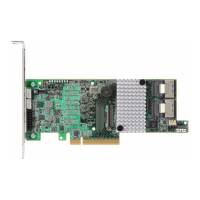LSI Corporation
- 9 -
MegaRAID SAS 9271-4i and SAS 9271-8i RAID Controllers Quick Installation Guide
June 2012
MegaRAID SAS 9271-4i and MegaRAID SAS 9271-8i RAID Controllers
8. Run the WebBIOS Configuration Utility.
Run the WebBIOS Configuration Utility to configure the groups and the virtual drives. When the message
Press <Ctrl><H> for WebBIOS appears on the screen, immediately press Ctrl+H to run the utility.
9. Install the operating system driver.
The controller can operate under various operating systems, but you must install the software drivers first.
The MegaRAID Universal Software Suite CD includes the software drivers for the supported operating systems,
along with documentation. You can view the supported operating systems and download the latest drivers for
RAID controllers from the LSI website at http://www.lsi.com/cm/DownloadSearch.do. Access the download
center, and follow the steps to download the driver.
Refer to the MegaRAID SAS Device Driver Installation User Guide on the MegaRAID Universal Software Suite CD for
more information about installing the driver. Be sure to use the latest service packs that are provided by the
operating system manufacturer and to review the readme file that accompanies the driver.
3 Supported RAID Levels
This RAID controller supports drive groups using the following RAID levels:
RAID 0 (data striping) – Data is striped across all drives in the group, enabling very fast data throughput. No data
redundancy exists. All data is lost if any drive fails.
RAID 1 (drive mirroring) – Data is written simultaneously to both drives in the drive group, providing complete
data redundancy if one drive fails. RAID 1 supports an even number of drives from 2 to 32 in a single span.
RAID 5 (drive striping with distributed parity) – Data is striped across all drives in the group. Part of the
capacity of each drive stores parity information that reconstructs data if a drive fails. RAID 5 provides good data
throughput for applications with high read-request rates.
RAID 6 (drive striping with distributed parity across two drives) – Data is striped across all drives in the group,
and two parity drives provide protection against the failure of up to two drives. In each row of data blocks, two
sets of parity data are stored.
RAID 10 (RAID 1 and RAID 0 in spanned groups) – RAID 10 uses mirrored pairs of drives to provide complete
data redundancy. RAID 10 provides high data-throughput rates.
RAID 50 (RAID 5 and RAID 0 in spanned groups) – RAID 50 uses both parity and drive striping across multiple
drives to provide complete data redundancy. RAID 50 provides high data-throughput rates.
RAID 60 (RAID 6 and RAID 0 in spanned groups) – RAID 60 uses both distributed parity across two parity drives
and drive striping across multiple drives to provide complete data redundancy and high fault tolerance.
NOTE Refer to the MegaRAID SAS Software User Guide for detailed steps on configuring groups and
virtual drives.
NOTE Refer to the MegaRAID SAS Software User Guide on the MegaRAID Universal Software Suite CD for more
information about RAID levels.

